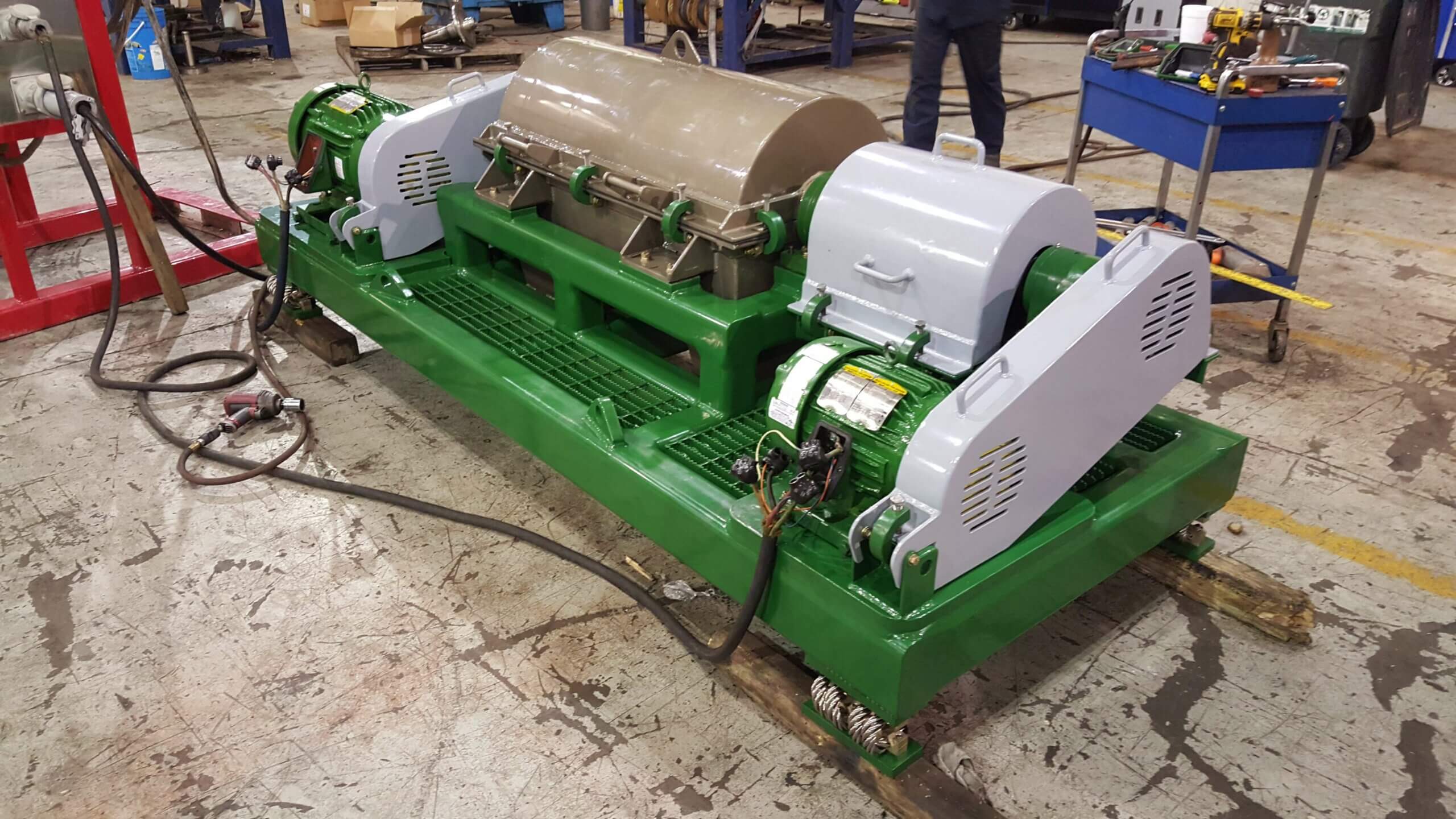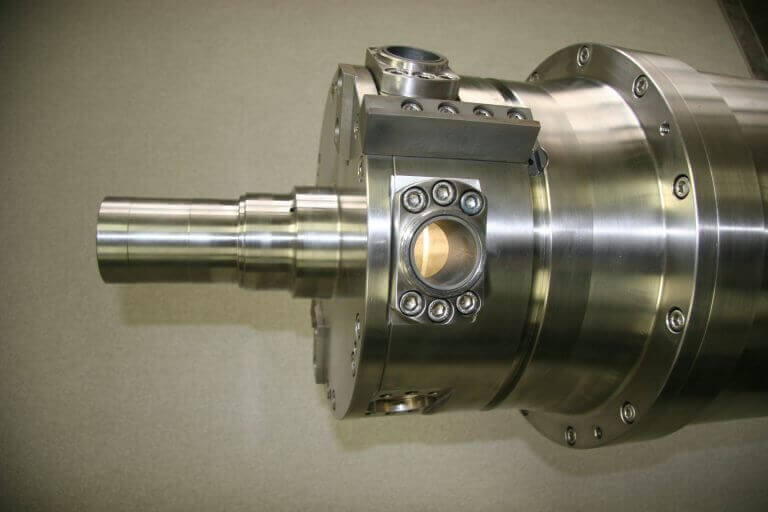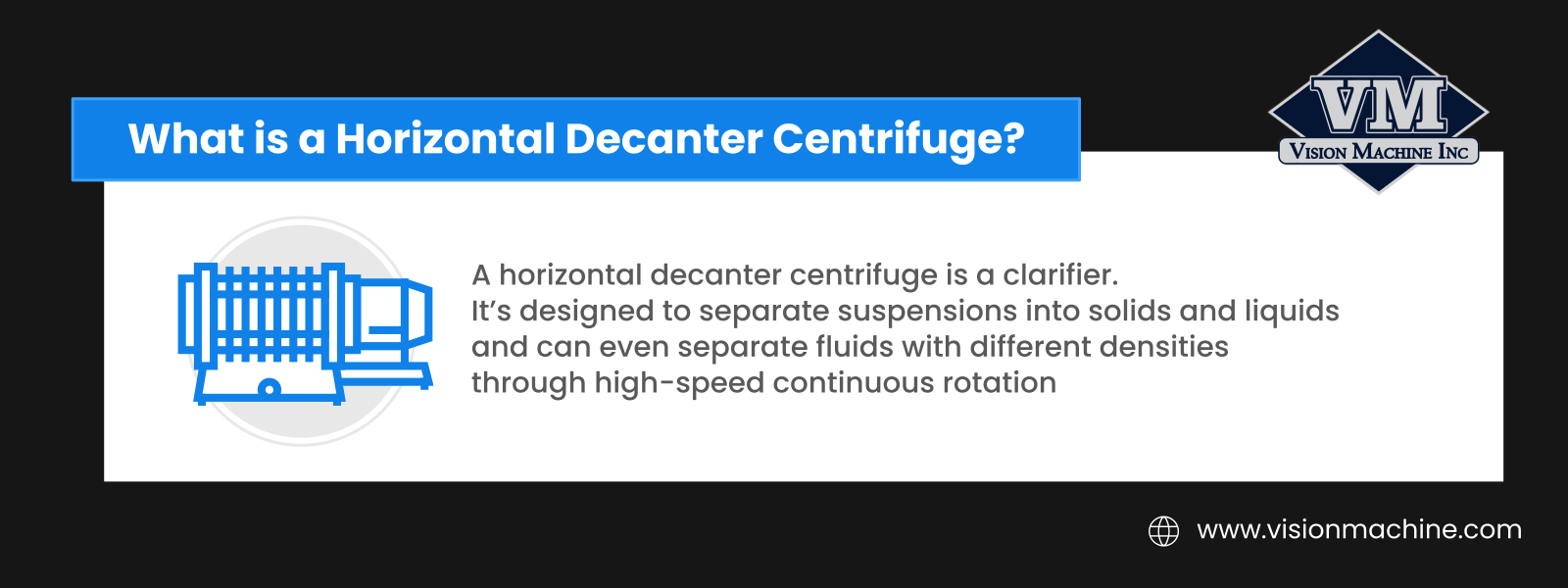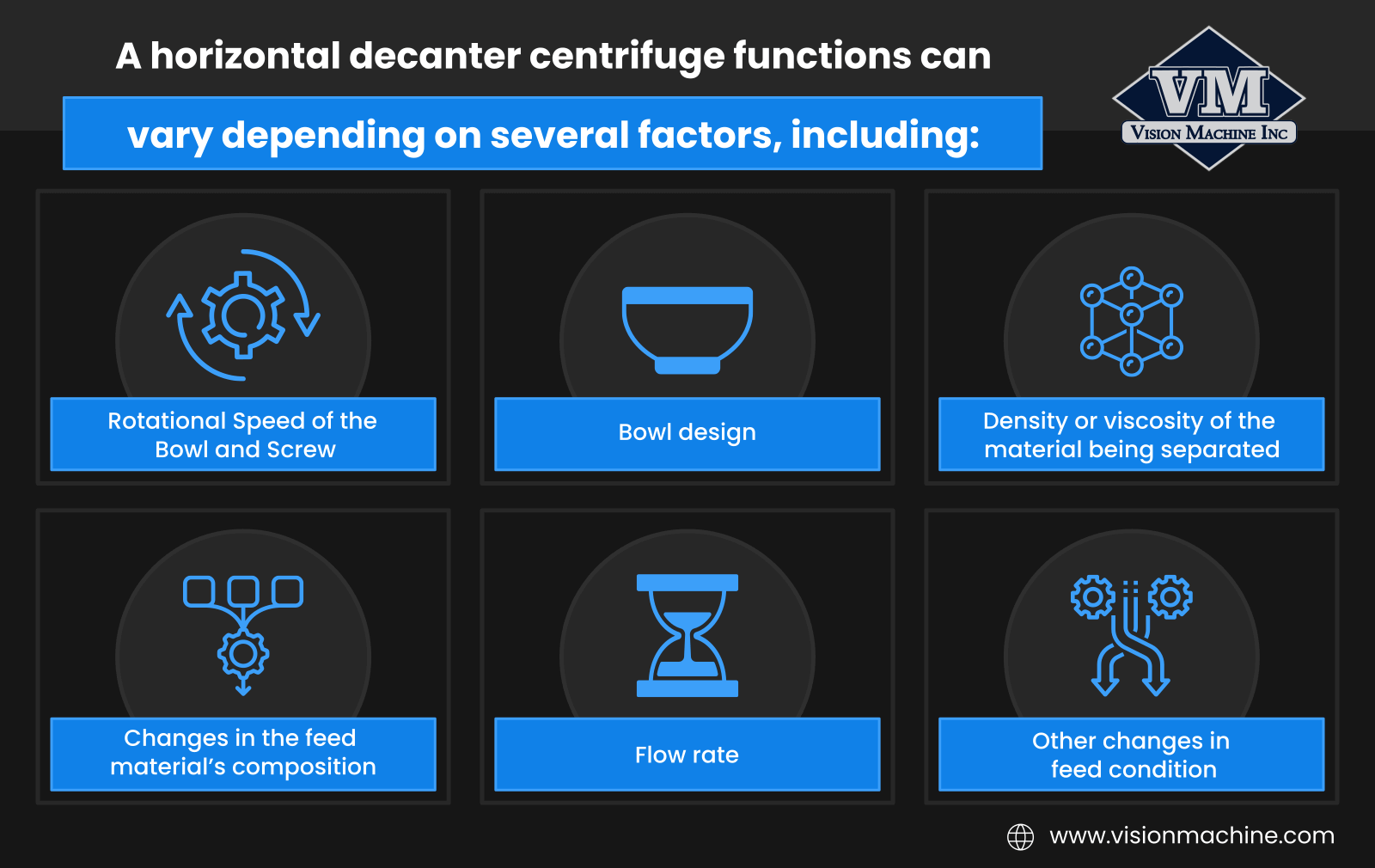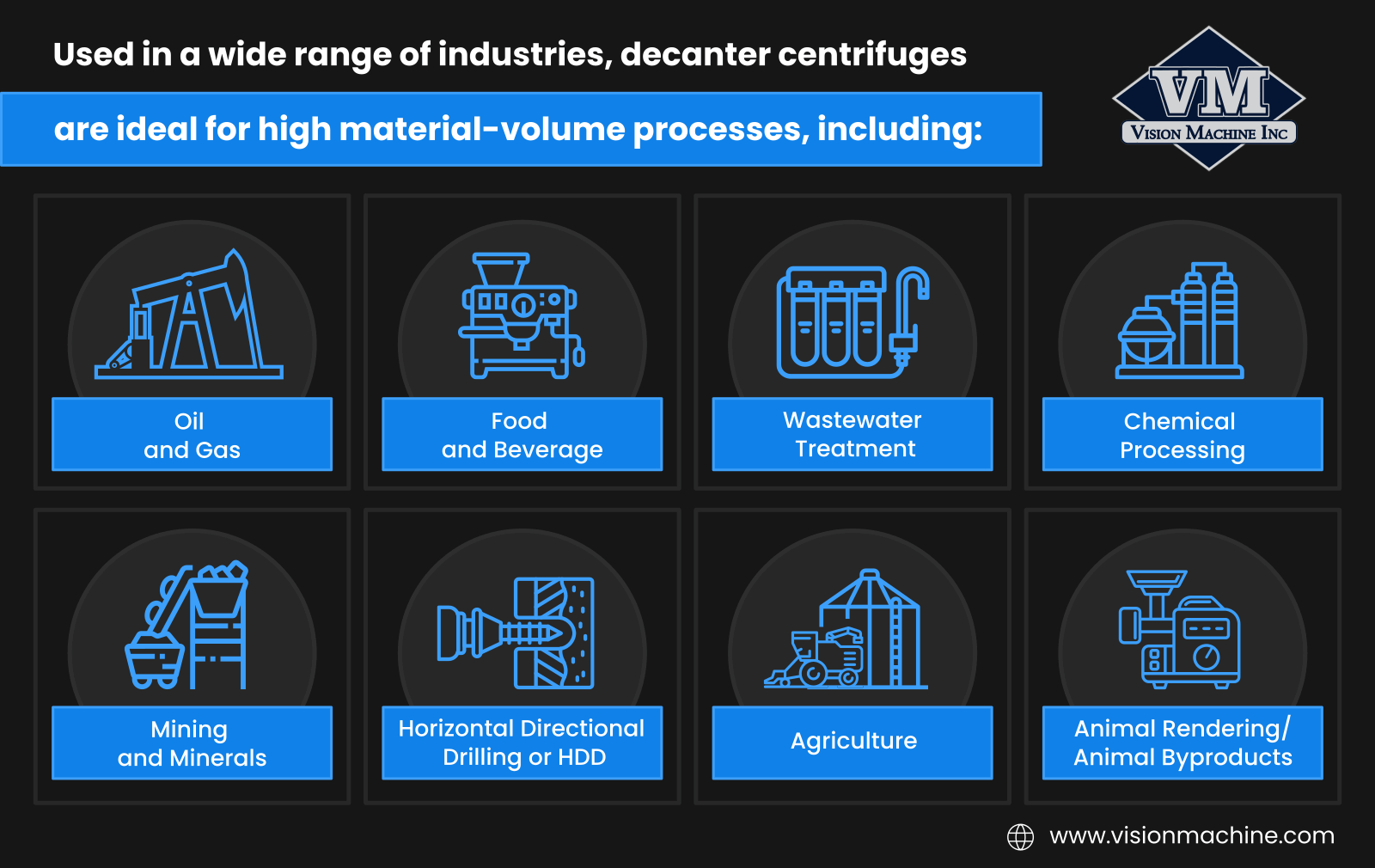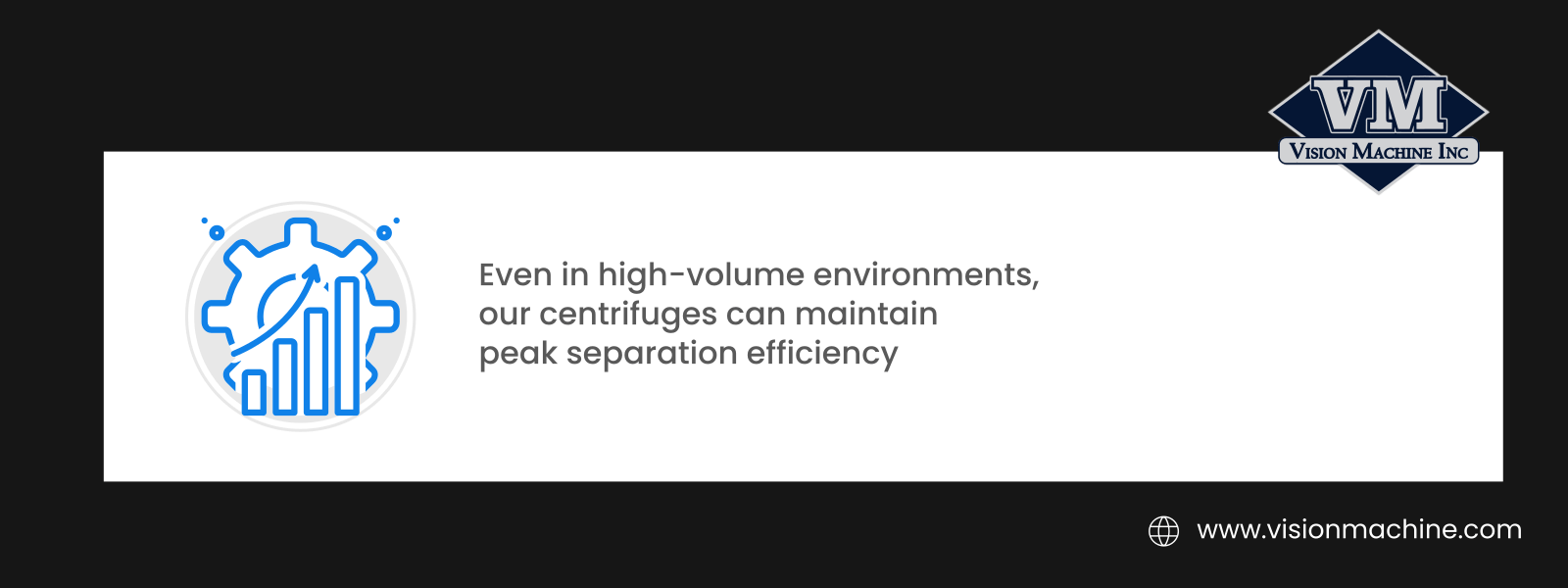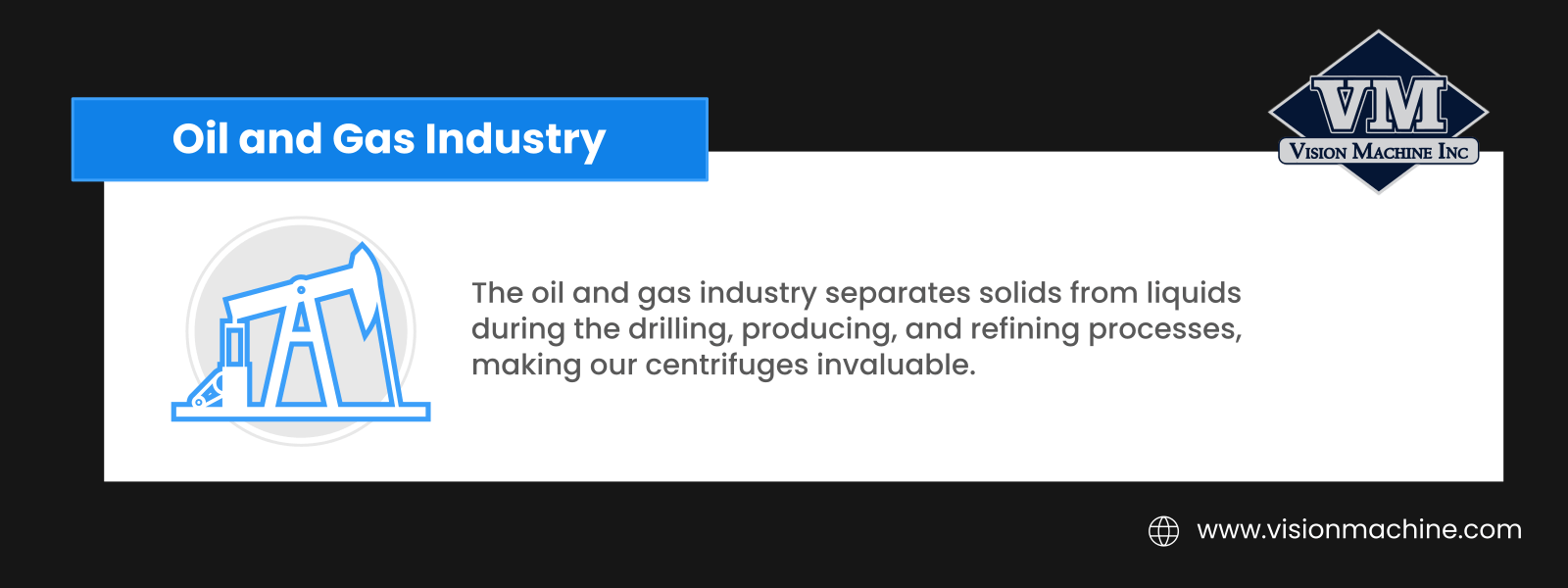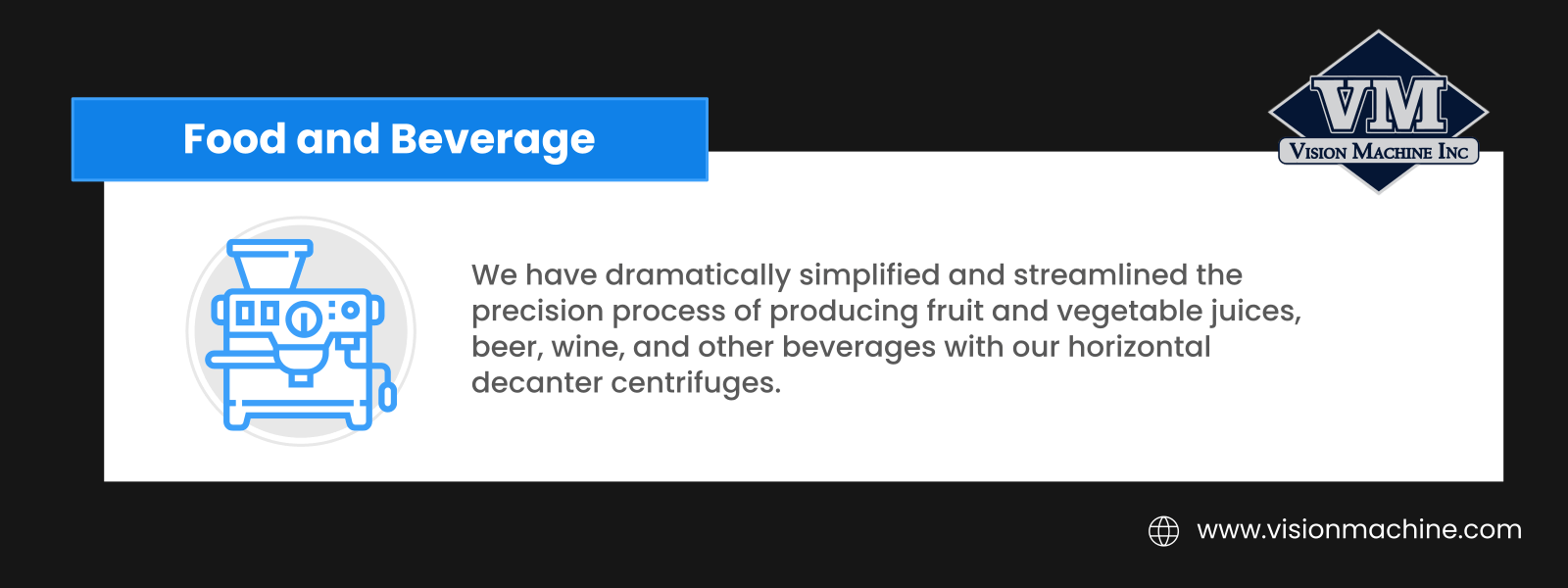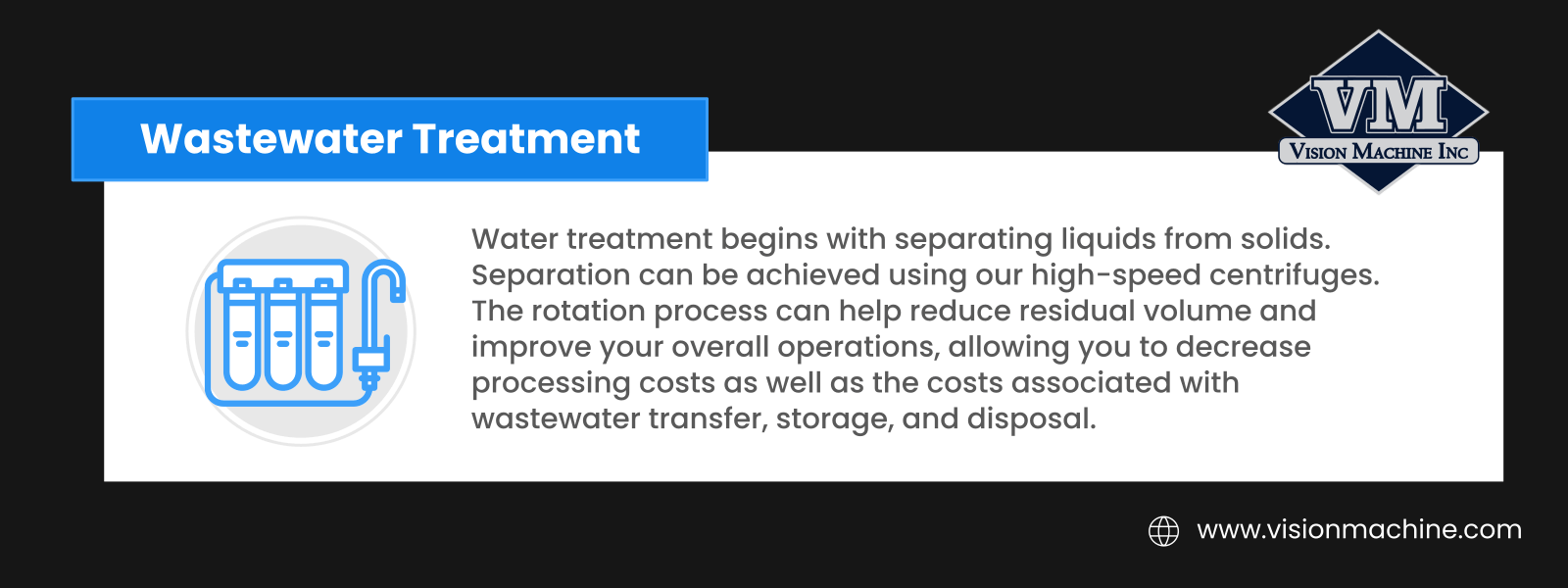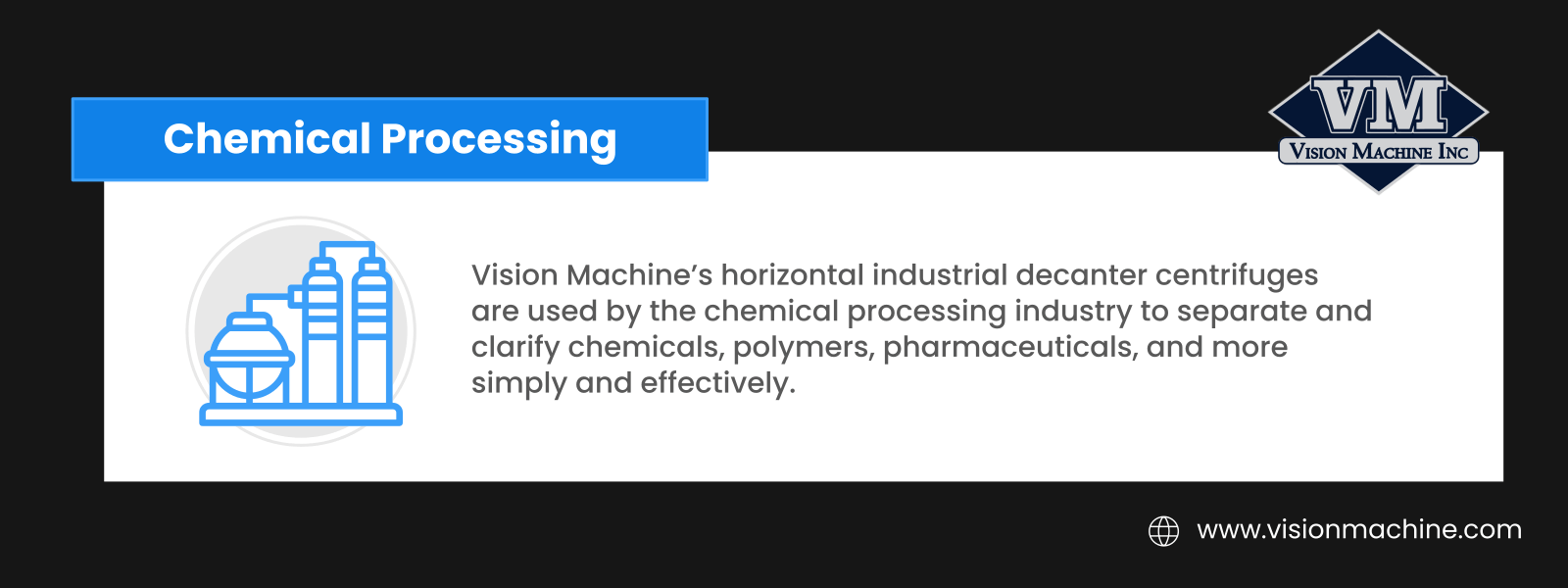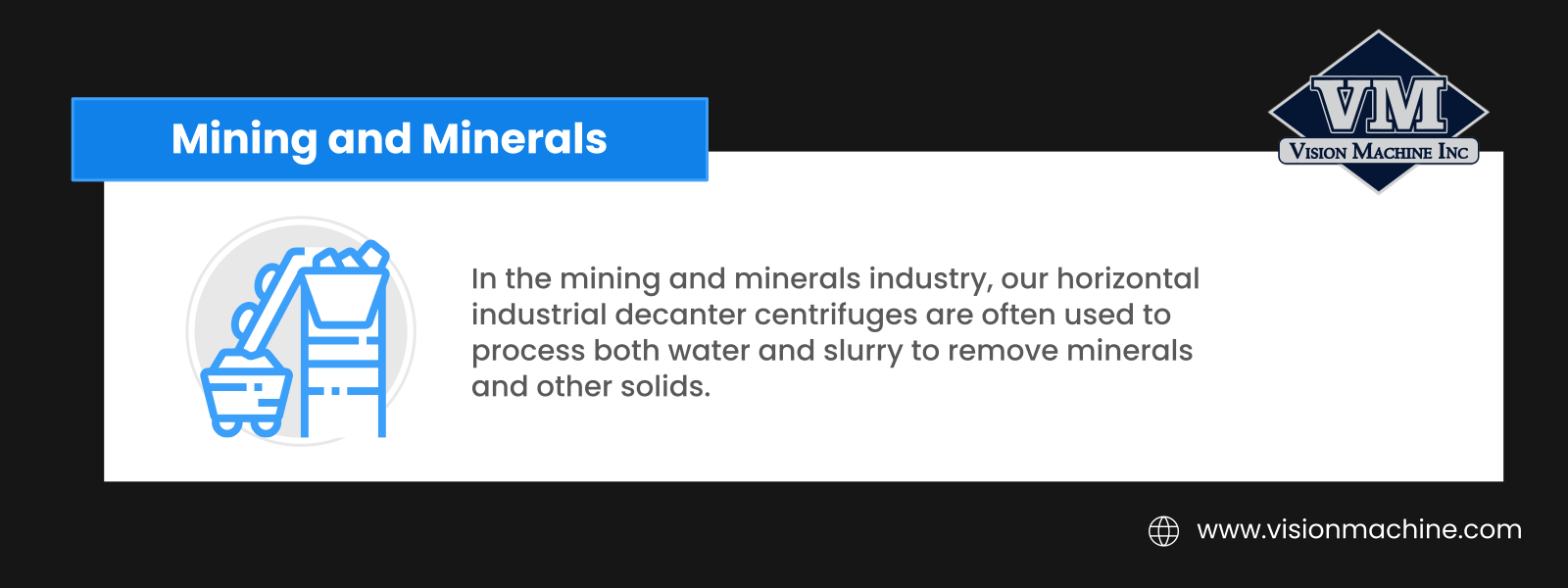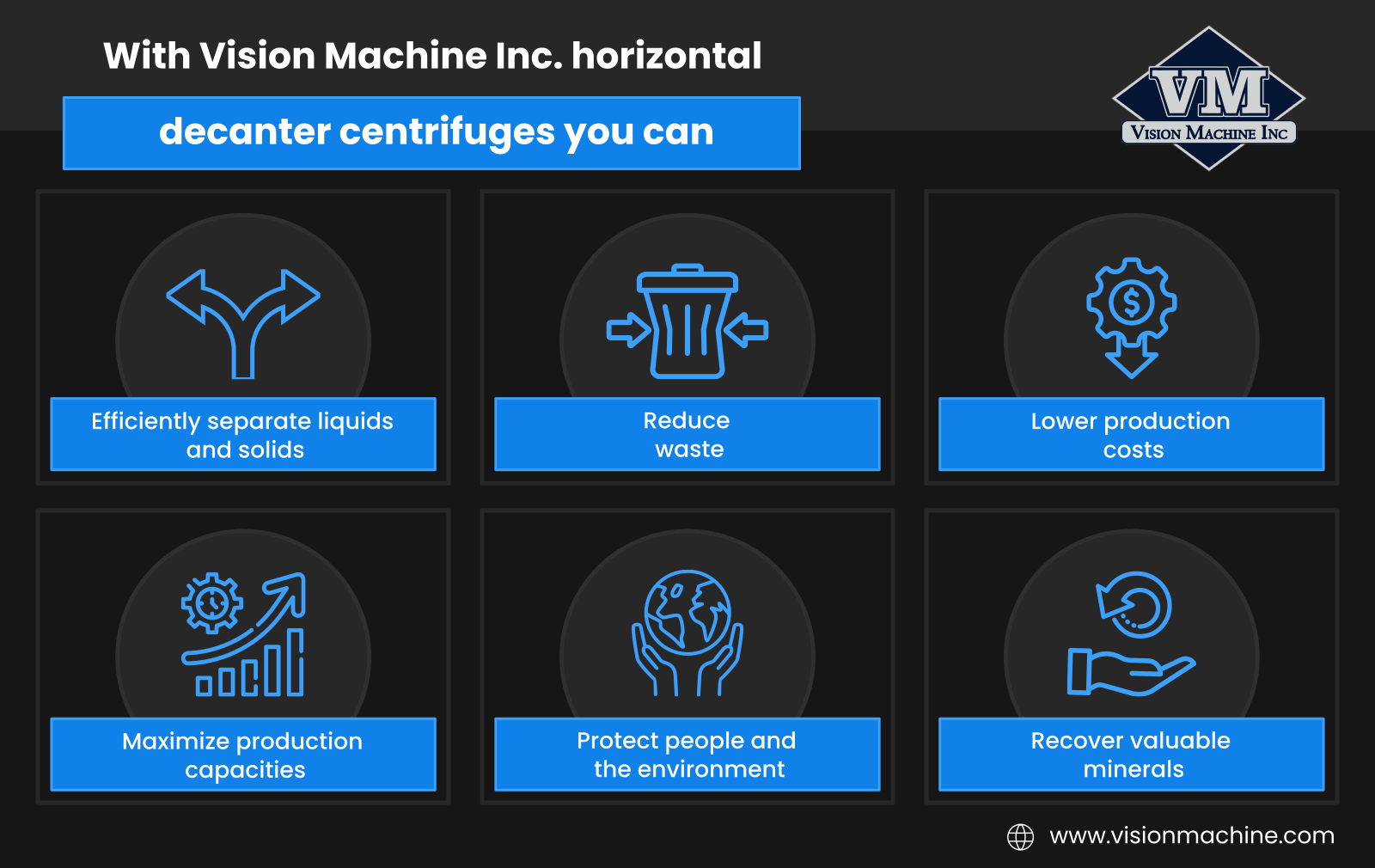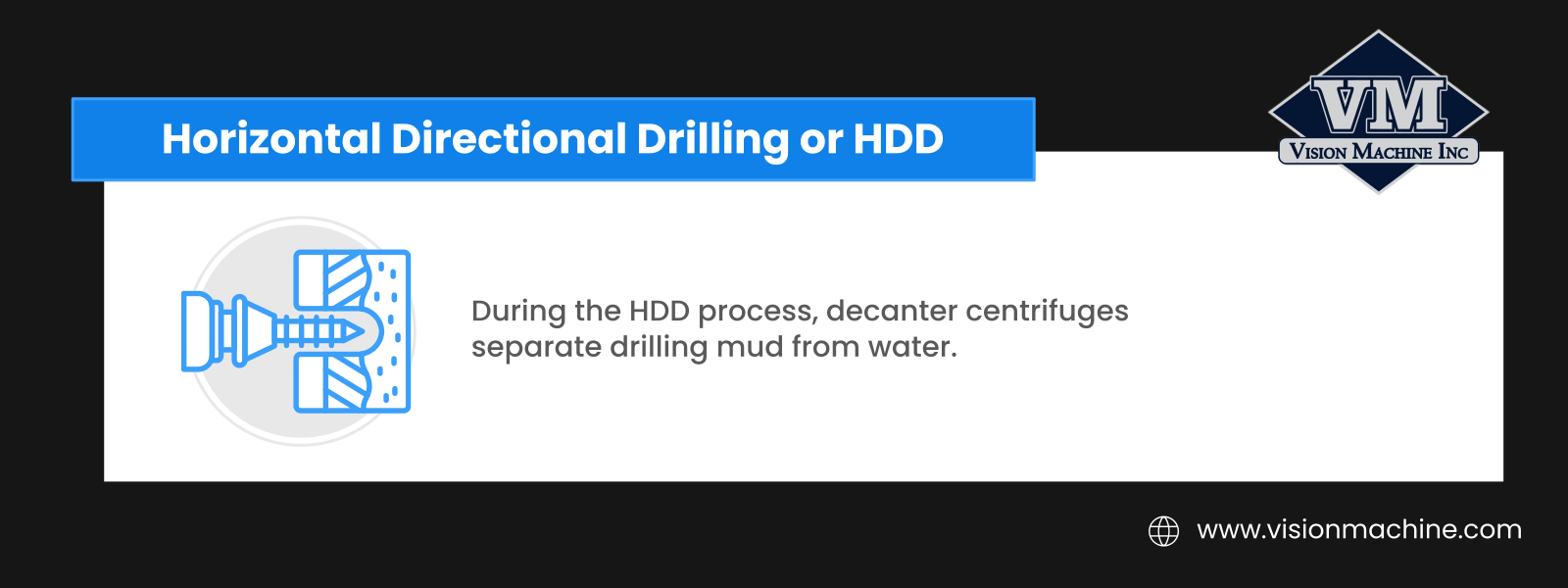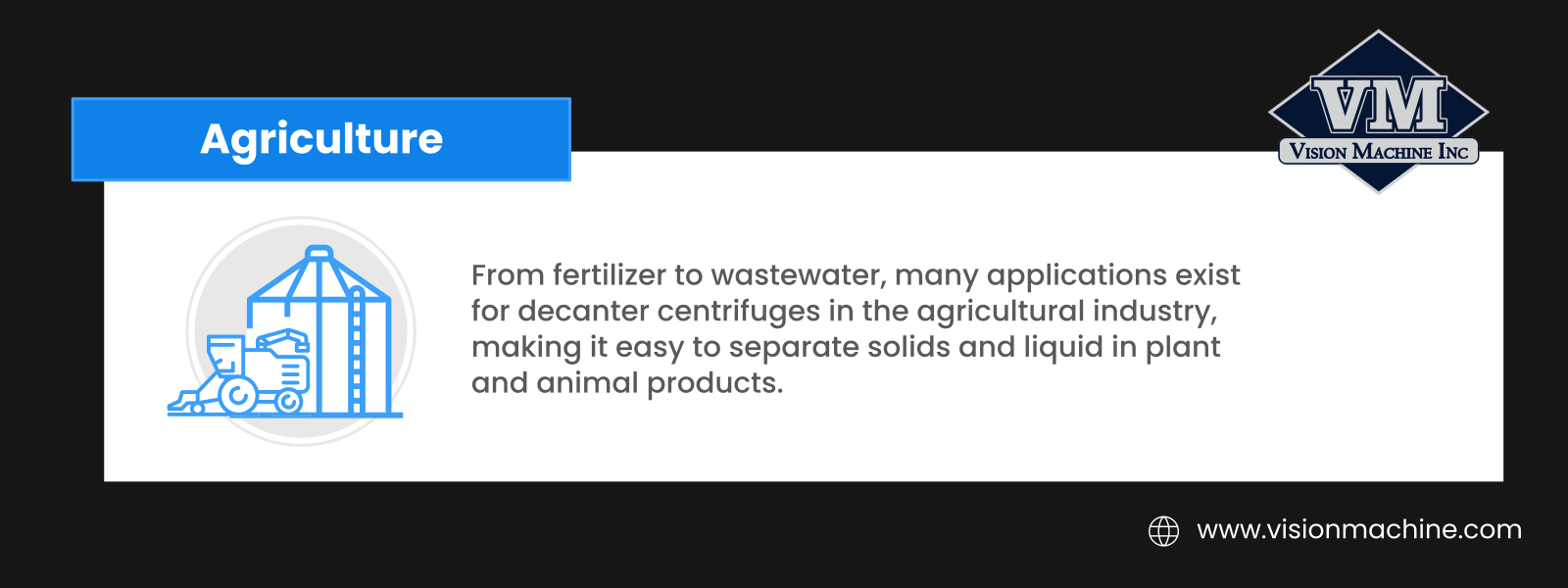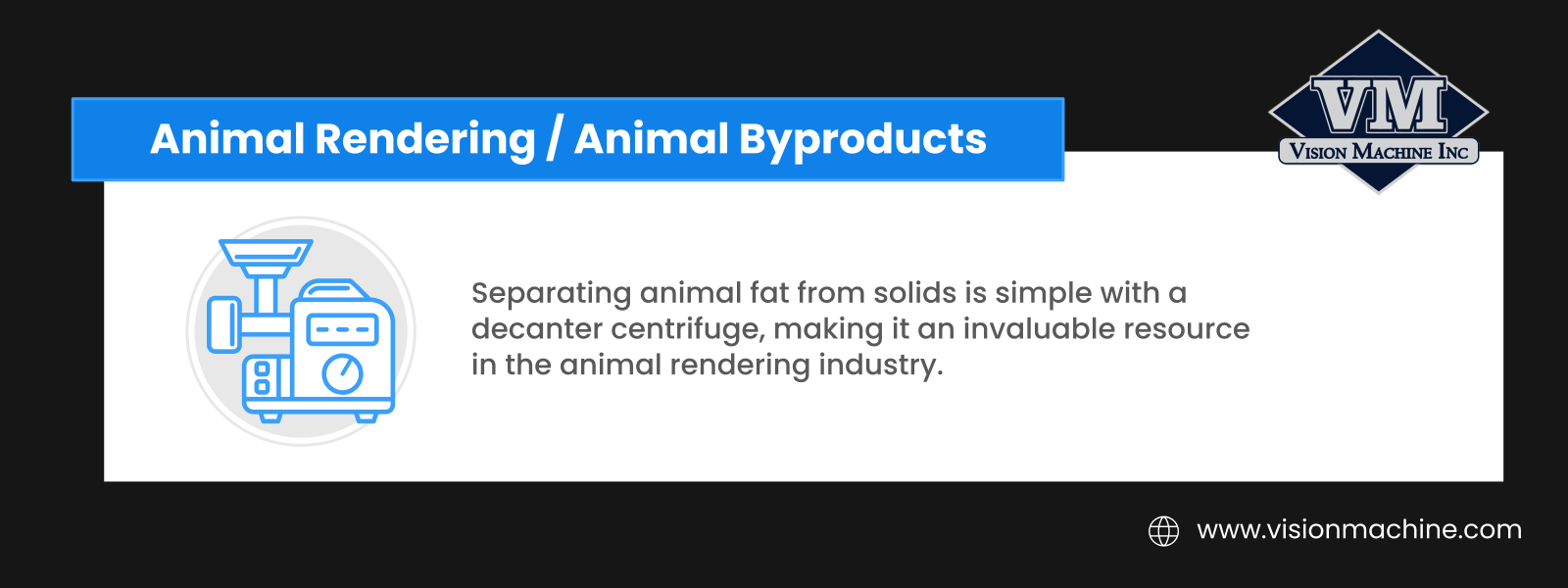Vision Machine Inc. is one of the leading decanter centrifuge manufacturers and specializes in the design and manufacture of horizontal decanter centrifuges. We’re an industry leader, manufacturing high-speed industrial equipment for a wide range of applications and businesses. Our horizontal decanter centrifuges are used in various industries such as oil and gas, chemical processing, the mining and minerals field, the food and beverage industry, and wastewater treatment. Our versatile, efficient equipment is also found in the agricultural industry, animal rendering/animal byproducts, and horizontal directional drilling (HDD). We offer many sizes and designs, with an emphasis on ease of use and maintenance. We also offer full-service centrifuge repair services and centrifuge parts.
We will help you find the cost-effective separation system solution that best meets your needs.
Types of centrifuges we manufacture:
- (18×50 machine)
- (14×48 machine)
- (16-1/2×55 machine)
- (20×70 machine)
- (24×84 machine)
- (10×30 machine)
Solids discharge design
Our patent pending solids discharge design is exclusive to our company. Field replaceable carbide wear inserts, also has carbide case plows and head plows. Click here for more information
What is a Horizontal Decanter Centrifuge?
At its most basic level, a decanter centrifuge is a clarifier. It’s designed to separate suspensions into solids and liquids and can even separate fluids with different densities through high-speed continuous rotation.
How a decanter centrifuge separates solids
Liquids of different densities or solutions with solids, which are denser than liquids, are the best candidates for centrifuge clarification.
Also known as a solid bowl centrifuge or horizontal bowl centrifuge, a decanter centrifuge is commonly used in various industrial processes. Consisting of a bowl with a solid wall, a cylinder, and a cone, the equipment is designed to rotate, which creates a centrifugal force. The solids are shifted to the wall of the bowl, and the clarified liquid phase remains in the middle of the bowl. The helical screw conveyor moves along the bowl’s walls to move the solids to the discharge point, which allows the solids to be collected and removed.
Horizontal decanter centrifuges are highly efficient, versatile, and easy to customize according to industry needs.
How well a horizontal decanter centrifuge functions can vary depending on several factors, including:
- Rotational speed of the bowl and screw
- Bowl design
- Density or viscosity of the material being separated
- Changes in the feed material’s composition
- Flow rate
- Other changes in feed condition
Solid-Liquid Separation Process
Used in a wide range of industries, decanter centrifuges are ideal for high material-volume processes, including:
- Food and beverage industries
- Oil and gas industries
- Mining and minerals
- Chemical processing
- Agricultural field
- Animal rendering and byproducts
- Horizontal directional drilling or HDD
Reliable and simple to both use and maintain, horizontal decanter centrifuges are popular in many applications. They can achieve a high degree of separation efficiency, and they can be further customized according to your needs, making them incredibly versatile. We can even optimize their performance with specific tweaks during the design process.
Vision Machine is one of the top decanter centrifuge manufacturers because we specialize in them, offering a wide selection of centrifuges and customizing them according to what you need and want.
Industrial Decanter Centrifuges
Even in high-volume environments, our centrifuges can maintain peak separation efficiency. For this reason, they’re often used in many industrial applications. From treating wastewater and processing chemicals or pharmaceuticals to the mining and mineral field, our equipment can handle it all.
High-Speed Industrial Decanter Centrifuges
Vision Machine’s decanter centrifuges are designed to effectively dewater, separate, and clarify suspensions. Most commonly used in the food and beverage industry to remove fine particles such as protein from milk, these centrifuges are built for precision and strength. These high-speed models can withstand high rotation speeds and resulting G-forces to deliver effective, efficient separation.
Horizontal Decanter Centrifuge Industries Served
At Vision Machine, we customize our equipment according to need and demand while maintaining the highest quality possible. We believe our quality and reputation are behind the popularity of our decanter centrifuges and stand behind our products.
The oil and gas industry
The oil and gas industry separates solids from liquids during the drilling, producing, and refining processes, making our products invaluable.
How Industrial Decanter centrifuge technology is used in oil and gas
Treating slop and sludge is essential to preserving environmental integrity. Our decanter centrifuges can simplify the slop treatment process. The suspension clarification process can also help minimize discharge by removing everything from oil to bentonite and cement from the liquid in question.
We take pride in manufacturing big bowl decanters, a sought-after feature in the oil and gas industry. These decanters are uniquely designed to process, treat, and separate drilling mud, accomplishing this effectively and efficiently through high-speed rotation in a single continuous operation. The integration of the latest technology and processes within our state-of-the-art facilities ensures that our decanter centrifuges are not only reliable but also of superior quality. Trust Vision Machine Inc. to provide you with robust solutions for your most demanding operational needs.
Food and Beverage
We have dramatically simplified and streamlined the precision process of producing fruit and vegetable juices, beer, wine, and other beverages with our horizontal decanter centrifuges.
How it’s used in food processing
The food and beverage industry has very precise needs and requirements. Vision Machines supports the food and beverage industry with equipment that is efficient, precise, and easy to clean and maintain.
As one of the top horizontal centrifuge manufacturers, we make the solid liquid separation process more efficient. With our centrifuges, you can quickly and easily clarify beer, wine, fruit juices, vegetable products, applesauce, and other food and beverage products. You’ll achieve maximum juice extraction, the utmost in the clarified liquid phase, and drier “cake” or extracted solids.
Vision Machine manufactures centrifuges with flexible designs to make it easier to adapt the product based on the substance or process for a higher-quality end product. You will have the maximum level of control for streamlined separation and superior results.
Wastewater Treatment
Water treatment begins with separating liquids from solids. Separation can be achieved using our high-speed centrifuges. The rotation process can help reduce residual volume and improve your overall operations, allowing you to decrease processing costs as well as the costs associated with wastewater transfer, storage, and disposal.
How they are used in the sludge dewatering process for wastewater treatment industries
The sludge dewatering process requires the separation or removal of water from wastewater sludge. Using a decanter centrifuge makes sludge dewatering faster, simpler, and more efficient. Any liquid involved remains in the center of the bowl while the cake or solid particles are sent to the outer edge. There the solids can be collected for easier removal and disposal.
By using our highly effective horizontal decanter centrifuges, you can achieve maximum separation during the sludge dewatering process and lower your costs. You’ll even find they are easy to operate and maintain, making them the most cost-effective choice. We can customize our industrial centrifuges to fit industry-specific needs or product requirements.
Chemical Processing
Vision Machine’s horizontal industrial decanter centrifuges are used by the chemical processing industry to separate and clarify chemicals, polymers, pharmaceuticals, and more simply and effectively.
How it’s used in other industries like chemical processing
Chemical processing plants, the pharmaceutical industry, and others often use industrial decanter centrifuges to process clay slurry, epoxy resin, graphite, calcium fluoride, alumina, lead, sulfuric acid, mineral oil, mica, vitamins, and more.
In the chemical processing industry, standards are exact and precise. Mechanical separation is critical in the clarification process to ensure proper gravity, dehydrate suspensions, and classify solids mixtures. The one single continuous process made possible by our solid bowl centrifuges means that you’ll be able to separate products easily, effectively, and precisely.
Vision Machine understands the need for optimal performance, strict hygiene, and stringent guidelines in the pharmaceutical and chemical industries, which is why we offer additional customization options according to product specifications and client needs.
Mining and Minerals
In the mining and minerals industry, our horizontal industrial decanter centrifuges are often used to process both water and slurry to remove minerals and other solids.
How it’s used in the mining and minerals industrial separation industry
The mining and mineral industry can process titanium dioxide, calcium carbonate, kaolin, and other minerals and solids effectively and precisely using our centrifuges. The resulting minerals and their pigments can then be used in an array of applications, including paper production, paint manufacturing, or ceramic stabilization. Contact us to see how Vision Machine separation equipment can assist in mineral processing applications
With our solid bowl centrifuges, you can:
- Efficiently separate liquids and solids
- Reduce waste
- Lower production costs
- Maximize production capacities
- Protect people and the environment
- Recover valuable minerals
With a rotating solid-bowl design, you’ll be able to achieve maximum clarification. The centrifugal force sends even the smallest solid particles to the edge of the bowl for collection. The liquid remains in the bowl for easier collection or disposal.
Our products are built for lasting durability using the highest-quality material and leading-edge technology, making them a cost-effective solution for the mining and mineral fields.
Horizontal Directional Drilling or HDD
To install underground cables, conduits, and pipelines, workers must drill a bore path along a precise route while avoiding surface disruptions and sediment release. Solid-bowl centrifuges facilitate this process with precision and simplicity.
How it uses industrial centrifuges
During the HDD process, decanter centrifuges separate drilling mud from water.
Agriculture – Solid liquid separation equipment
From fertilizer to wastewater, many applications exist for decanter centrifuges in the agricultural industry, making it easy to separate solids and liquid in plant and animal products.
Animal Rendering / Animal Byproducts
Separating animal fat from solids is simple with a decanter centrifuge, making it an invaluable resource in the animal rendering industry. With a solid-bowl centrifuge, you can quickly and easily process animal carcasses, proteins, and waste materials to remove lard and tallow for use elsewhere. The remaining proteins can be used in a wide range of products, including animal feed and aquaculture.
Contact Vision Machine Inc. Today!
At Vision Machine Inc., we are constantly innovating and transforming our high-speed industrial centrifuge equipment. We offer numerous customization options to better accommodate high treatment capacities, large or small particles, low or high viscosity, dry cake, low concentration, and solutions that are complex or difficult to separate. We can also provide adjustments for high-density differences between liquids and solids.
Contact Vision Machine Inc. today to learn more about our superior service and how our horizontal decanter centrifuges can facilitate and improve your industrial process. We would love to help you explore our series of products or learn more about various customization options that we provide customers. We’re also happy to provide a quote. Reach us by phone at 832-562-2112 or by email at sales@visionmachine.com.


